An informal candidate guide
I often give advice to new candidates, so I thought I'd jot down some of the common stuff.
How to get on the ballot
This is very brief, but the basics are that you show up during the week of filing and fill out some paperwork. This is always earlier than you expect - to be on the ballot in November of 2024 you had to file in Nov 2023, for example. If you are running on a party ballot, they then sign some documents and you (often) write them a check (called the 'filing fee'). For state candidates filing takes place at the state house, for county candidates the county courthouse, and for city candidates either the courthouse or the city hall.
If you are running in a non-partisan race, you'll probably need to pick up a packet to collect signatures from registered voters in advance. This should be available at the place you'll file. At the time of writing (December 2023) some parties let you waive the filing fee by collecting signatures from registered voters in advance. Check with the party to confirm.
The parties can make it easier to run for office, and the Democratic Party of Arkansas has a page where you can sign up to run, however, parties often rely on candidates to navigate things themselves, so while you can sign up on their website to run for something, you might never hear from them again, so it's always better to make sure you know when filing is, and be ready to sign up that week.
Campaign Structure
Basic Roles
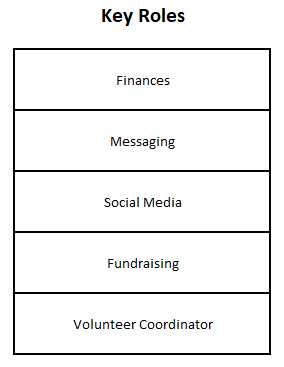 A campaign can be as few people as you want, or as many. In my experience having two people you trust and can call on is
a minimum, and those people should be your first asks. I recommend Finance, as reporting to the state is time-intensive
and repetitive. The second person could cover social media, and should be someone you take with you to events to take
photos and post them. Adding a third person, you can have someone to help keep your fundraising or volunteer efforts on track.
Finally, messaging can be as simple as someone to proofread what you want to say, or as complicated as someone writing press releases
for you.
A campaign can be as few people as you want, or as many. In my experience having two people you trust and can call on is
a minimum, and those people should be your first asks. I recommend Finance, as reporting to the state is time-intensive
and repetitive. The second person could cover social media, and should be someone you take with you to events to take
photos and post them. Adding a third person, you can have someone to help keep your fundraising or volunteer efforts on track.
Finally, messaging can be as simple as someone to proofread what you want to say, or as complicated as someone writing press releases
for you.
This core group will probably fill many roles, and will also be the people you bounce ideas off of. You'll often see them referred to as the 'kitchen cabinet' - the people you might sit around the kitchen table with to figure out how the campaign is going to run.
You will often hear people talk about a campaign manager, especially in the context of hiring one. This is just a person who is going to fill some or all of these roles, and offer advice about how to run your campaign. They are often the people who help with messaging and might also take on other roles. If you are hiring one, knowing which roles they will cover can help you figure out what they should cost.
Advanced Roles
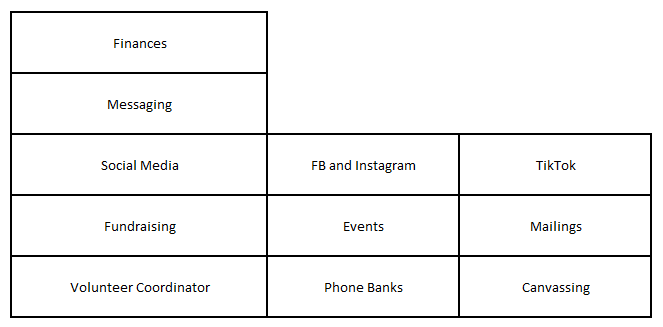 Once you have the key positions filled, if you can, recruit more volunteers to take specific pieces of the campaign.
An example might be to break out your social media to a couple of people, each handling one platform. Your Volunteer
Coordinator might benefit from people put in charge of areas of your district, for example one person per neighborhood or
town. Your fundraising person might want an Events Coordinator who can build and run each fundraising event.
You might want someone to do opposition research - figuring out how your opponent voted on issues (if they held office)
so you can point out their record to the voters.
Once you have the key positions filled, if you can, recruit more volunteers to take specific pieces of the campaign.
An example might be to break out your social media to a couple of people, each handling one platform. Your Volunteer
Coordinator might benefit from people put in charge of areas of your district, for example one person per neighborhood or
town. Your fundraising person might want an Events Coordinator who can build and run each fundraising event.
You might want someone to do opposition research - figuring out how your opponent voted on issues (if they held office)
so you can point out their record to the voters.
Campaign basics
You should plan to set up the following:
- Website - this doesn't have to be much - any free website provider is good enough to get started (e.g. Wix or Weebly). You don't need a lot - most people will not go beyond the landing page, so a picture, a couple key points, and a big donate button are enough.
- Social Media pages - you can set them up everywhere, but you'll probably want one on any platform you will advertise on. Do not use your personal social media for the campaign.
- Email address - just something different from your personal email. Gmail is fine, although an email that matches your website looks nice.
- bank account - any bank account will work, but a separate bank account is definitely a good idea. There are special rules banks have to follow, and often your local bank person won't know about them, so be prepared for shenanigans. I have twice been called to bring in additional paperwork after the account was already open and accepting donations.
- Donation processor - this is ActBlue or GoodChange or RaiseTheMoney - someone who will take a credit card and put the money in your bank account, and keep the records you are legally required to collect.
These are optional - some people like having them, but they aren't necessary:
- PO Box - you can just get mail at home, but some people are more comfortable not giving that out. Most of your mail will be checks people send you, hopefully!
- Phone - the actual number of phone calls you will receive as a candidate is surprisingly low, even if you give out your personal number. As with the PO Box, some people prefer to have a separate phone. Some tools you might look at include Google Voice, or a VoIP provider like Zoom (the video conferencing software company). Or just get a cheap contract for a separate mobile phone from someone like Mint Mobile.
Data for Your Campaign
Basic data you'll need
 There are basically two databases candidates will need. To be clear, 'database' can just mean 'spreadsheet' or 'list'.
One database or list will be everyone related to your campaign. I've called this the 'People' database.
This usually starts with the candidate's so-called Rolodex,
or list of people they know. NDTC has a
Rolodex reference guide
to help you figure out what information you might need, but usually something as simple as name and contact info will
get you started. Once you have that list, you can mark them as donors, volunteers, or anything else.
There are basically two databases candidates will need. To be clear, 'database' can just mean 'spreadsheet' or 'list'.
One database or list will be everyone related to your campaign. I've called this the 'People' database.
This usually starts with the candidate's so-called Rolodex,
or list of people they know. NDTC has a
Rolodex reference guide
to help you figure out what information you might need, but usually something as simple as name and contact info will
get you started. Once you have that list, you can mark them as donors, volunteers, or anything else.
The other database is the VAN, which is just a list kept by the state party that lists all the registered voters. It also has things like their voting history, and how likely they are to vote for one party or the other. In some cases it may tell you about particular issues they care about. Because it's a list of all voters, it's easier to keep this list separate from your people list. In theory you can manage your list inside the VAN, but you really need to know the VAN well to make this work.
Who uses your people data?
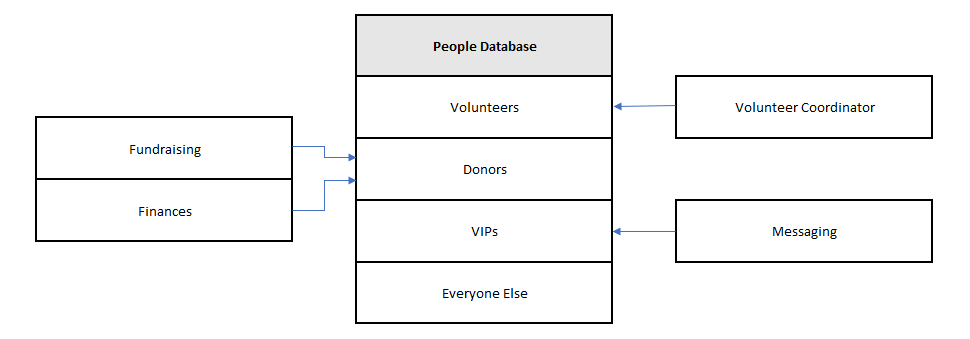 Some basics for who is using which data - Fundraising will use your people data to find people who might donate, and
keep donation history, contact history, things of that nature. Finance will use the donor data to file necessary reports
about your donations, as well as knowing how much money you have to spend on things. The volunteer coordinator will
keep and build the list of volunteers, using it to contact volunteers regularly to let them know about opportunities.
Messaging might use your list of VIPs to send out press releases or get particular feedback on topics (VIPs might be
influential people in your district, but they might or might not be supporters of your campaign!)
Some basics for who is using which data - Fundraising will use your people data to find people who might donate, and
keep donation history, contact history, things of that nature. Finance will use the donor data to file necessary reports
about your donations, as well as knowing how much money you have to spend on things. The volunteer coordinator will
keep and build the list of volunteers, using it to contact volunteers regularly to let them know about opportunities.
Messaging might use your list of VIPs to send out press releases or get particular feedback on topics (VIPs might be
influential people in your district, but they might or might not be supporters of your campaign!)
Who uses the VAN?
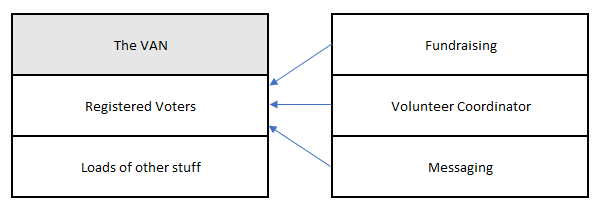 Since the VAN is all registered voters, it will be used by the Volunteer Coordinator to build out walk lists or phone bank
lists. Messaging might use it to tell how many people in your district support a topic. Fundraising might use it for
finding supporters you don't personally know.
Since the VAN is all registered voters, it will be used by the Volunteer Coordinator to build out walk lists or phone bank
lists. Messaging might use it to tell how many people in your district support a topic. Fundraising might use it for
finding supporters you don't personally know.
Communications and Outreach
It is often said that people have to see your name and hear your message three times to take it in. Since Arkansas doesn't have any sort of voter guide, and the news media is not particularly effective, it will basically be incumbent on the candidate to reach every voter.
There are a lot of ways to do this, however, some are more effective and cost-effective than others.
A non-exhaustive list of the ways to reach voters:
- At their door
- By phone (call)
- By text message
- Social Media
- Internet advertising
- By e-mail
- By mail
- On the radio, TV, or newspaper
- Billboards
- Events
- Word of Mouth
Reaching voters at their door is the gold standard - having a conversation with a voter is the best way to communicate your ideas to them. It's also free, but it takes a lot of time.
Reaching voters by phone is a close second - again, having a conversation with a voter is the best way to communicate your ideas to them. Also free, also takes a lot of time. The VAN can automate some of this, allowing you to make calls faster.
Reaching voters by text message is very popular these days. This also allows a direct conversation with the voter. Many tools exist that let you send text messages to a lot of people all at once, and have conversations only with those folks who respond. This is very time-efficient, and fairly cost effective. It can be difficult to tell if you've reached the person you intended to reach, although some tools will auto fill the name, which can help when someone replies 'this isn't that person'.
Reaching voters by social media is effortless, but can be tricky because it requires people to subscribe to your social media, or have something shared/go viral. Those who do subscribe may or may not engage further, but it does give you an avenue to ask for donations and announce events. The DPA emphasizes keeping your personal and candidate pages/accounts separate.
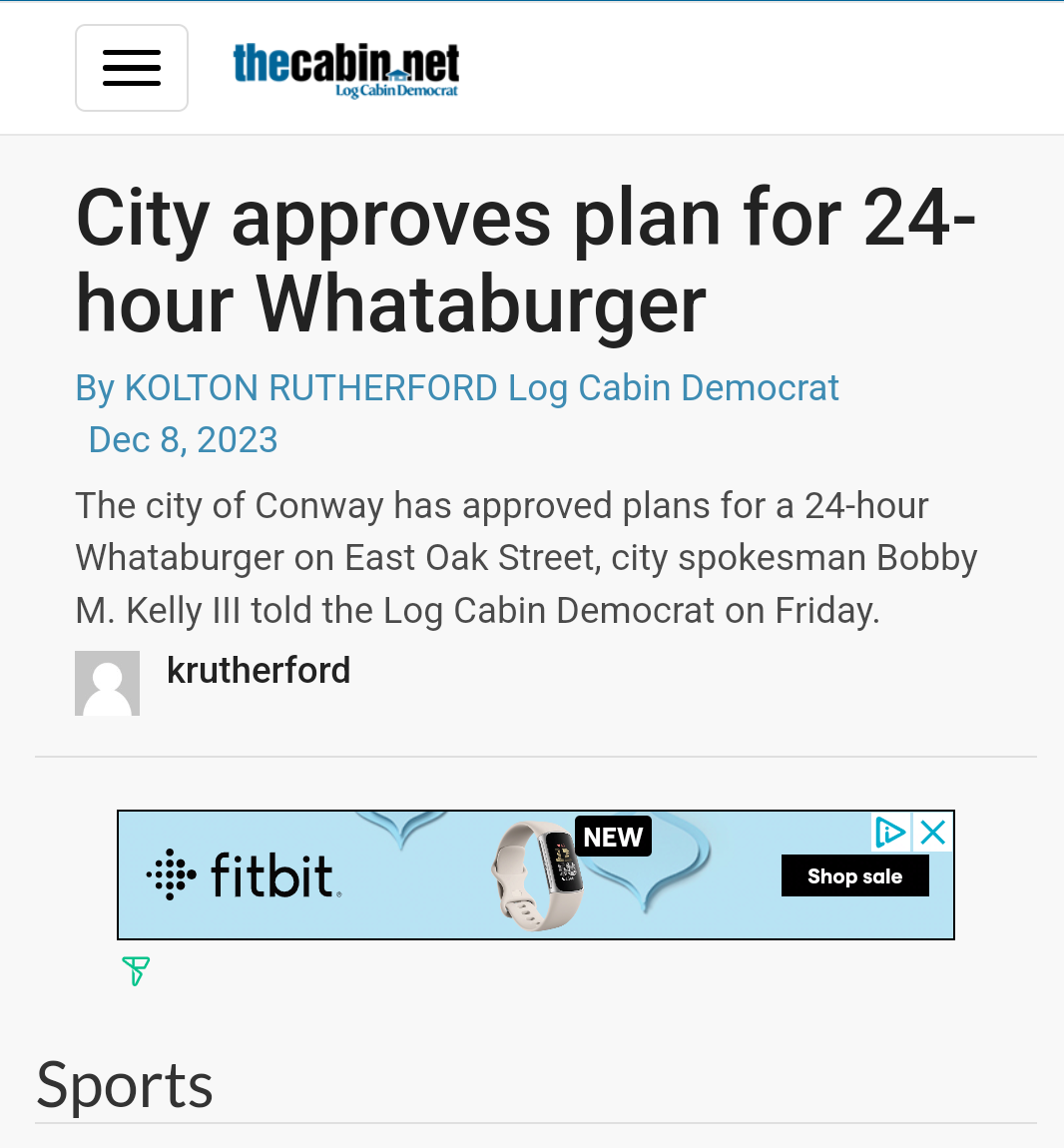 An example ad.
An example ad.Reaching voters by mail is classic. Most print houses will get bulk discounts that lower the cost per piece of mail, but it's still quite pricy compared to everything else. Handwritten notes can save on print costs. Pro Tip: Send postcards to voters before or after canvassing their neighborhoods to "layer" your touch.
Every Door Direct is a USPS specific thing that lets you put a card in every mailbox on a route. For some areas this might sense, but generally it's considered too scattershot. Remember that sending your material to someone who doesn't support you might motivate them to vote against you.
Reaching voters by e-mail is a bit tricky. Spam rules require people to sign up to receive messages, which puts you in the same boat as other methods that require you reach the voter first. Always have an email signup form at all events (as well as a volunteer signup). There are many tools that allow you to automate the process of sending bulk emails. Examples: ActiveCampaign, MailerLite, MailChimp, FloDesk.
You should be able to break the email lists into segments, which allows you to communicate e.g. one message to Faulkner County and another message to Pulaski County, which makes the email more relevant.
Billboards are easier now that there are digital billboards - the price is within reach of most campaigns. If you've seen the billboard, you might want to call and ask what it costs to be on the billboard!
Ad buys on TV or the radio or newspaper can be a cost effective way to reach voters. ConwayCorp is a local cable system with very reasonable rates. On the other hand, if you need to buy radio that covers many people who can't vote for you, it can be cost-prohibitive.
If you are putting together a video ad remember that it can probably do double duty as a TV ad. Audio can go on the radio and on podcasts or internet radio like Spotify. There are special rules about what has to be in a broadcast ad, so be sure to follow those - in theory, the people selling the ad should check, but better safe than sorry. Some places don't accept political ads (e.g. ESPN, TikTok)
Event advertising might be things like digital displays at the local fair or Toad Suck Daze.
Events might be put on by you or others, and give people a reason to come out and hear your message. Again, this relies on people knowing about the event, so requires someone (you or the organizer) to promote it. This one may also suffer from post-pandemic feelings towards in-person events (this is my speculation, but it seems like it's harder to get people to come out these days).
Word of Mouth is the dream scenario, where someone tells someone else about your campaign. Free and effortless. Absolutely impossible to predict or measure, but you can ask people to talk to their friends and neighbors, for example.
Candidate Tips
Any expense you incur because you are running a campaign, that you would not spend in your normal, everyday life is probably a legitimate expense the campaign can pay for / reimburse you for. Mileage and meals and child care (there was a special case about this one) and etc. Be smart, err on the side of caution, and when in doubt call the Ethics Commission.
If you put money into the campaign to get it started, list it as a loan to the campaign, or a donation to the campaign. Both can be paid back (timing differs). You should not spend your own money on your campaign if you can avoid it - you're giving your time and energy, don't backrupt yourself as well!
You don't have to get an EIN but it isn't hard to do and it makes it easier to file some paperwork, so you might as well. There's a webpage on IRS.gov that lets you get it, and 'political' is one of the options you can choose.
I used Google Sheets, but any spreadsheet will do for tracking expenses. I had four sheets - mileage, donations, expenses, and loans (see my note above about loans)
Events can be a great way to build support, and to demonstrate that you have support. If you aren't the type of person who likes to throw a party, reach out to friends who do like to throw parties, and ask them to throw you one.
Although in general merchandise isn't a great investment, some people will want t-shirts or coffee mugs or things like that. If possible, find a volunteer to manage this stuff, as managing and delivering merchandise can take a lot of time, without generating a lot of votes. This is especially true of signs - delivering signs to supporters could be a full time job if you allow it to be.
For printed materials, one consultant recommended 6x11 or 8-1/2x11 mailers that have big text and only one message - because people don't spend a lot of time reading these before they throw them out, you want your message to be large, clear, and concise.
For the most part, plan to spend your money at the end of the race. People have short memories, so getting your message out early won't work on most people. If you plan to make attacks, do those at the very end of the race when they can influence voters, and your opponent won't have time to use them against you.
Consider a layered approach to marketing, for example the 'Facebook/Instagram sandwich' - before sending a mailer, upload the people we're mailing to social media targeting, so they see the ad online, then in their mailbox, then online again.
If you make your push card a door hanger it's easier to leave when people aren't home. If you have the printer cut off the top they become standard push cards. You could also have 'Sorry I missed you' post-it notes printed which make it look like you left a personal message. You can further customize this by using the same color ink to write a note on the post-it as you leave it.
In general, it's important to track what is working and what isn't. Use a special donation link or tag for each type of ask you do, or a special landing page for each ad you run, to be sure you know who is responding to what, and where your money isn't going as far.
Suggested things to do very early in the campaign:
1 - if you have a friend that can use a spreadsheet, ask them to file your reports with the county or state. It's easy to do, doesn't require a lot of time, and frees up some mental space.
2 - ask a friend to sit with you while you call people and ask them for money. Call your friends, call friends of friends, call strong Dems. Start now, even if it's 1 hour/week. People might say they are focused on the nonpartisan races (hooray!). Tell them you''ll call them back after.
3- Early on there are lots of people getting motivated for school board and other non-partisan races. Note who they are and call them when the election is over. After the election, call the candidates you know and ask them who might help you.
4- any phone calls or door knocking you do early on can motivate people to vote in the non-partisan elections. Don't tell them how to vote, just tell them to vote. If you're talking to Dems you can ask them to volunteer or donate, and remind them to vote at the same time.